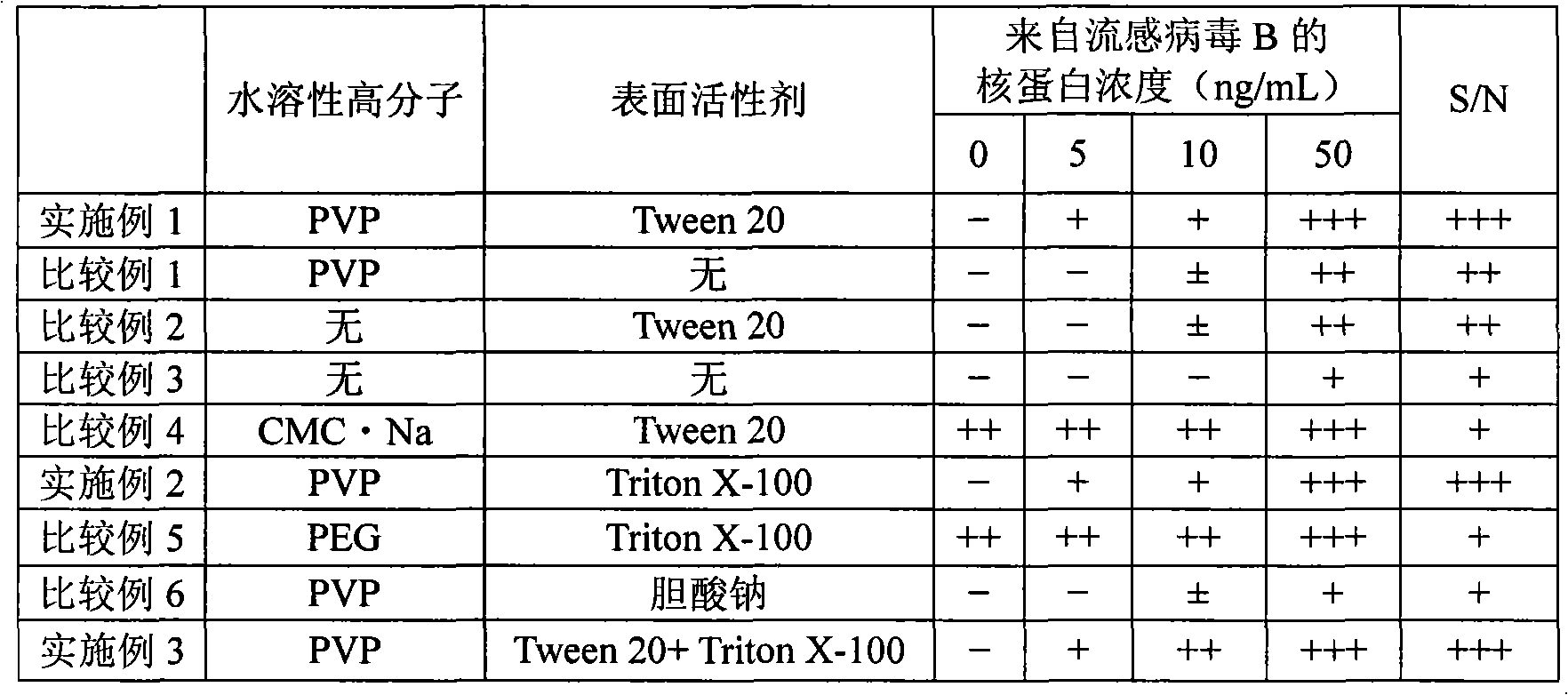Developing solution for immunochromatography, and measurement method using same
A technique of immunochromatography and developing solution, which is applied in the field of determination of substances to be detected, can solve the problems of not being able to obtain positive signals, and achieve the effect of inhibiting non-specific reactions and improving stability.
- Summary
- Abstract
- Description
- Claims
- Application Information
AI Technical Summary
Problems solved by technology
Method used
Image
Examples
Embodiment 1
[0075] 1. Preparation of Reaction Sites onto Chromatographic Media
[0076] Using an antibody applicator (manufactured by BioDot), apply an anti-influenza virus B monoclonal antibody diluted to a concentration of 1.0 mg / mL with a phosphate buffer solution (pH 7.4) containing 5% by weight isopropanol to 25×2.5 cm nitrocellulose membrane (manufactured by Millipore: HF 120), and dried at 50° C. for 30 minutes. After drying, the nitrocellulose membrane was soaked at 30° C. for 30 minutes in 200 mL of a phosphate buffer solution (pH 7.4) containing 0.5% by weight of casein (manufactured by Wako Junpharma Co., Ltd.) to block. After blocking, it was washed with a washing solution containing 0.05% by weight of Tween 20, dried overnight at room temperature, and the reaction site was prepared on a chromatographic medium.
[0077] 2. Preparation of Labeling Substance Solution
[0078] Add 0.1 mL of anti-influenza virus B monoclonal antibody diluted to a concentration of 0.1 mg / mL with ...
Embodiment 2
[0092] Using the chromatographic medium prepared in Example 1, as a developing solution, except that 0.3% by weight of Triton X-100 was used instead of Tween 20, other measurements were performed in the same manner as in Example 1. The results are shown in Table 1.
Embodiment 3
[0098] Using the chromatographic medium prepared in Example 1, as a developing solution, except that 0.05% by weight of Tween 20 and 0.3% by weight of Triton X-100 were used instead of 0.5% by weight of Tween 20, other measurements were performed in the same manner as in Example 1. The results are shown in Table 1.
[0099] Table 1
[0100] closed
[0101]
[0102] Comparing the above-mentioned Examples 1-3 with Comparative Examples 1-3 shows that in the presence of a nonionic surfactant and PVP as an ethylenic water-soluble polymer having a polar group containing an oxygen atom, high sensitivity can be obtained. The detection was from the nucleoprotein of influenza virus B. On the other hand, when sodium carboxymethylcellulose (CMC·Na) or polyethylene glycol was used as the water-soluble polymer, non-specific adsorption was found also in negative test samples (Comparative Examples 4 and 5). When the ionic surfactant sodium cholate was used together with PVP, detection w...
PUM
| Property | Measurement | Unit |
|---|---|---|
| particle size | aaaaa | aaaaa |
| particle size | aaaaa | aaaaa |
Abstract
Description
Claims
Application Information
 Login to View More
Login to View More - R&D Engineer
- R&D Manager
- IP Professional
- Industry Leading Data Capabilities
- Powerful AI technology
- Patent DNA Extraction
Browse by: Latest US Patents, China's latest patents, Technical Efficacy Thesaurus, Application Domain, Technology Topic, Popular Technical Reports.
© 2024 PatSnap. All rights reserved.Legal|Privacy policy|Modern Slavery Act Transparency Statement|Sitemap|About US| Contact US: help@patsnap.com










